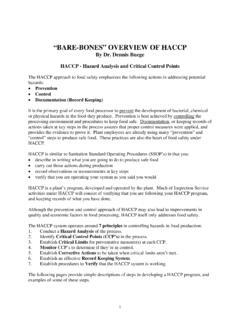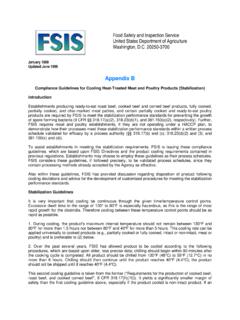Transcription of Table 1. Minimum growth temperatures for selected ...
1 Bruce Tompkin Armour Swift-Eckrich 1 Table 1. Minimum growth temperatures for selected foodborne pathogens. Minimum growth temperatures Salmonellae1 Pathogenic E. coli L. monocytogenes Y. enterocolitica Campylobacter jejuni Staphylococcus aureus Bacillus cereus2 psychrotrophic strains Clostridium perfringens Clostridium botulinum nonproteolytic proteolytic 7C 7-8C 32C 7C 4C 12C 10C 38F 50F 1 One report of initial growth on bacon at 5C but then the population decreased. 2 While growth of B. cereus occurs in milk at refrigeration temperatures ( , <7C), there is no evidence for this in meat and poultry. One study reported death of vegetative cells in ground beef at ( ) and below. Parasites ( , Trichinella spiralis, Taenia spp., Toxoplasma gondii) and viruses do not multiply in meat or poultry products. Source: International Commission on Microbiological Specifications for Foods.
2 1996. Microorganisms in Foods: Microbiological Specifications of Food Pathogens. Blackie Academic & Professional, New York. Bruce Tompkin Armour Swift-Eckrich 2 Table 2. Estimated time (hours) for a ten fold increase at 50, 60 and 70F. Estimated Time (hours) to increase from 10 to 100 CFU/ml 50F (10C) 60F ( ) 70F ( ) Salmonellae E. coli O157:H7 aerobic anaerobic L. monocytogenes aerobic anaerobic Y. enterocolitica 107 50 123 38 58 68 24 21 38 16 27 31 9 9 16 8 16 16 Source: USDA ARS Pathogen Modeling Program Version Conditions: broth medium, pH , salt , sodium nitrite Bruce Tompkin Armour Swift-Eckrich 3 Table 3. Public health significance of meat and/or poultry held at 40-50F ( to 10C) during storage and/or distribution. Pathogen1 Estimated No. of cases of illness from meat/poultry2 Estimated cost/year (billion)3 Foods most likely to be involved4 Impact of 40-50F on growth of the pathogen5 T.
3 Gondii 2,056 raw pork None. This parasite can not multiply in meat or poultry products. Campylobacter 1,031,000-1,313,000 - poultry None. C. jejuni/coli can not multiply below about 90F. S. aureus 756,000 cooked meat/poultry None. S. aureus is a poor competitor and would not grow in raw meat or poultry at 50F or below. Most outbreaks involve cooked products that become contaminated and are held at 75-100F in the presence of air. L. monocytogenes 808-837 ready-to-eat foods Little, if any. Listeriosis has not been linked to raw meat or poultry . The potential for growth in some ready-to-eat foods does exist. C. perfringens 50,000 cooked products None. C. perfringens can not grow below about 54F Bruce Tompkin Armour Swift-Eckrich 4 E. coli O157:H7 6,000 - 12,000 undercooked ground beef Little, if any. The Minimum temperature for growth is about 45F. At 50F, from 2 to 5 days would be needed for a 10 fold (1 log) increase depending on available oxygen Salmonellae 549,000-2,745,000 undercooked meat/poultry Little, if any.
4 The Minimum temperature for growth is about 45F. At 50F, about 4 days may be needed for a 10 fold (1 log) increase. Source: 1,2,3 Department of Agriculture, FSIS, Proposed Rule. 1995. Federal Register 60: 6881-6881. (This source was used for "the pathogens," "estimated cases", and "estimated cost/year") 4,5 The "foods most likely to be involved" and the "impact of 40-50F" are based upon the scientific literature. Notes: The Federal Register notice listed 50-75% of salmonellosis cases as being due to meat/poultry. The 75% value was used for the above estimate of cases. Recent estimates from the Center for Disease Control indicates the total number of cases of listeriosis is about 1100/year. Thus the number of cases from meat/poultry (50% of the total) now would be estimated at about 550/year. Bruce Tompkin Armour Swift-Eckrich 5 Table 4. Estimated time (hours) for a one log increase of typical spoilage bacteria at 40, 50 and 57-59F.
5 Applicable to raw meat and poultry. Estimated time (hours) to increase from 10 to 100 CFU/ml Isolate and strain # (4-5C) 50F (10C) 57-59F (14-15C) Pseudomonas (92) Pseudomonas (69) Ps. fluorescens Ps. fluorescens (P-200) Ps. fluorescens Ps. fragi Pseudomonas (21-3c) Pseudomonas (1-3b) Enterobacter aerogenes (Ps48) Gram negative rod aerobic anaerobic Gram negative rod Achromobacter (7) Achromobacter (438) Achromobacter (5) Pseudomonas (451) 39 49 27 - 22 17 24 23 40 14 32 251 18 20 24 32 18 22 12 13 - 9 11 9 14 - - - 8 8 10 13 8 9 7 7 - - 7 8 7 - - - 5 4 5 4 1 Data obtained at 6C. Source: Adapted from Tompkin. 1973. Food Technol. 27(12):54-58. Bruce Tompkin Armour Swift-Eckrich 6 Table 5. Effect of temperature on time of spoilage for pork and poultry. Temperature (F) Days to spoilage A. Chicken 32 18 37 42 47 68 11 8 6 2 B. Pork 31 36 41 14 9 5 Source: A. Adapted from Shannon and Stadelman. 1957. J. Poult.
6 Sci. 36:121-123. B. Unpublished data from Swift and Company (before 1977). Bruce Tompkin Armour Swift-Eckrich 7 Table 6. Combined effect of temperature and bacterial content on time of spoilage of poultry and beef. Days to spoilage Temperature (F) Initial level of 100 CFU/cm Initial level of 100,000 CFU/cm A. Chicken 40 50 14 6 1 - 2 1 - 2 B. Beef 32 41 50 68 22 13 8 3 11 6 4 2 Source: A. Adapted from Ogilvy and Ayres. 1951. Food Technol. 5:97-102. B. Adapted from Ayres. 1960. Food res. 25:1-18. Bruce Tompkin Armour Swift-Eckrich 8 Table 7. Factors influencing the microbial content of ready-to-eat meat and poultry products from production through distribution/storage. Factor Measurement (s) Ingredients Types and levels of microorganisms in ingredients which can multiply and/or survive during subsequent processing, distribution and storage. Formulating The conditions of formulating and holding that may lead to microorganisms in finished product Heating The conditions of heating ( , time, temperature, humidity).
7 Cooling The conditions of cooling and potential for recontamination. Further processing The conditions of holding and further processing before packaging Product composition Brine content / water activity Type and amount of fermentable carbohydrate Product pH; type and level of acidulant Level of smoke, liquid or natural Phosphate content Level of residual nitrite Hot oil dipping or flaming to brown the surface Spices, condiments applied to the surface after heating Sodium lactate content Metal ion content Packaging Product temperature during packaging and palletizing Degree of vacuumization and leaker formation Rate of oxygen transmission through packaging materials Addition of oxygen scavengers Modified atmosphere content Contamination after heating Types and levels of microorganisms contaminating the product between heating and packaging. Distribution/storage Time-temperature history after packaging. Damage to packaging permitting contamination Source: Adapted from Tompkin, 1995.
8 The use of HACCP for producing and distributing processed meat and poultry products. pp. 72-108. In Pearson and Dutson (eds.), HACCP in Meat, Poultry and Fish Processing. Blackie Academic & Professional, New York. Bruce Tompkin Armour Swift-Eckrich 9 Options for arriving at time, temperature criteria for chilling, storage and distribution of meat and poultry. I. Chilling Rate A. Carcasses, head meat, variety meats 1. Specify time and temperature requirements based upon: a. predictive modeling and published research b. data submitted by industry through conferences such as this and other means c. survey of current commercial practice for rates of chilling carcasses d. microbial sampling of carcasses before and after chilling e. review requirements from other countries 2. Arbitrarily establish a performance standard a. for example, <2 log increase in salmonellae and E. coli O157:H7 3. Conduct a risk assessment (This is highly recommended) B.
9 Cooked meat and poultry products 1. Provide time and temperature guidance such as in the current guideline (FSIS Directive Rev. 1; 1-24-89) 2. Establish a performance standard a. for example, < log increase in C. perfringens II. Distribution/Storage A. All perishable meat and poultry that requires refrigeration for food safety 1. a. Establish an action level in the range of 40 to 50F because a critical limit based solely upon temperature does not exist in this range. A valid critical limit would have to specify time and temperature. b. A temperature of 45 or 46F (7 or 8C) is suggested. Bruce Tompkin Armour Swift-Eckrich 10 2. Establish performance standards a. for example, < log increase in C. perfringens b. for example, < log increase in salmonellae and E. coli O157:H7 III. If the action level or other crieria are exceeded: A. place product on hold B. collect information ( , time-temperature history) C.
10 Review information D. collect more information, if needed ( , sample and test) E. consider the food, its intended use and consumers of the product F. decide disposition: options; destroy, reprocess, freeze, divert to other safe use etc. G. implement decision H. follow through with corrective action to prevent future occurrences








